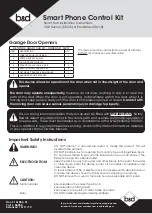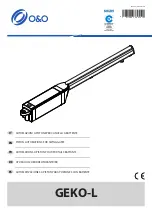
10
GB
I
D
Prima di iniziare l’installazione
verificare l’eventuale necessità di
ulteriori dispositivi e materiali che
possono servire a completare
l’automazione in base alla specifica
situazione d’impiego.
L’installatore deve controllare che il
range di temperatura dichiarato per il
motoriduttore (vedi cap. DATI TECNICI)
sia adatto al luogo d’installazione.
Il motoriduttore non può essere
utilizzato su cancelli dotati di porta per
passaggio pedonale, a meno che il
funzionamento del motoriduttore sia
impedito con la porta aperta.
Prima di installare il motoriduttore
assicurarsi che il cancello sia in buone
condizioni meccaniche, correttamente
bilanciato e che si apra e chiuda in
maniera corretta
Assicurarsi che sia evitato il pericolo
d’intrappolamento tra il cancello
aperto e le parti circostanti, in seguito
al movimento di apertura.
Eventuali pulsanti (normalmente
aperti/off) installati per l’attuazione del
motoriduttore devono essere
posizionati in modo tale che il cancello
sia a vista, ma distante dalle parti in
movimento. A meno che non funzioni
mediante chiave, deve essere
posizionato ad una altezza minima di
1,5 m e non accessibile al pubblico.
Dopo aver installato l’automazione,
assicurarsi che sia regolata
correttamente e che i sistemi di
protezione e lo sblocco funzionino
correttamente.
E vietato motorizzare un cancello che non
sia già efficiente e sicuro in quanto la
motorizzazione non può risolvere difetti
causati da una errata installazione o da
una cattiva manutenzione del cancello
stesso.
Durante l’installazione dell’automazione
fare costantemente riferimento alle norme
armonizzate EN 12453 e EN 12445.
Verificare che i singoli dispositivi da
installare siano adatti all’automazione che
si intende realizzare, con particolare
attenzione ai dati riportati nel cap. DATI
TECNICI. Non proseguite se anche uno
solo dei dispositivi non è adatto all’uso.
Accertarsi che il luogo di installazione
dell’automazione non sia soggetto a
inondazioni o allagamenti, fonti di calore
o fiamme, incendio o situazioni di pericolo
in genere.
Durante l’installazione tenere protetti i
componenti dell’automazione per evitare
che vi possano penetrare all’interno liquidi
(es. pioggia) e/o corpi estranei (terra,
ghiaino, ecc.).
Il materiale dell’imballaggio deve essere
smaltito nel pieno rispetto della normativa
locale.
Indossare occhiali di protezione quando
si devono praticare i fori di fissaggio.
Nel caso di lavori in quota (sopra i 2 m da
terra), ad esempio per installare il
segnalatore luminoso o l’antenna, è
necessario che il personale compente sia
attrezzato di scale, imbraghi di sicurezza,
casco di protezione ed quant’altro previsto
dalle leggi e dalle norme per l’esecuzione
di tali lavori. Fare riferimento alla direttiva
89/655/CEE modificata dalla 2001/45/CE.
The person who installs the operator
is responsible for performing risk
analysis and regulating the
automation’s safety devices
consequentially.
Before commencing installation, check
whether further devices or materials
are needed to complete the automation
in order to suit the specific situation
in which it will be used.
The Fitter must check that the
temperature range declared on the
operator (see Technical Data Chap.) is
suited to the place in which the device
is installed.
The operator cannot be fitted on gates
with separate pedestrian access,
unless operator function is prevented
when the door is open.
Before installing the operator, ensure
that the door is in good mechanical
conditions, correctly balanced and that
it opens and closes correctly.
Ensure that the risk of entrapment
between the open gate and
surrounding parts following the
opening movement is prevented.
Any normally open/off buttons installed
for the activation of the operator must
be positioned so that they are within
view of the gate but distant from
moving parts. Unless said devices
operate using keys, they must be
positioned at a minimum height of
1.5m and not accessible to
unauthorised persons.
Once the automation has been
installed, ensure that it is correctly
adjusted and that the protection
systems and release work properly.
It is strictly forbidden to motorise a gate
that is not already efficient and secure as
the automation cannot resolve faults
caused by incorrect installation or poor
maintenance of the gate.
During installation, make constant
reference to harmonised standards EN
12453 and EN12445.
Ensure that the individual devices to be
installed are suitable for the automation
that one intends to create, paying careful
attention to the points raised in the
TECHNICAL DATA chapter. Do not
proceed if even just one device is
unsuitable for the intended use.
Ensure that the place of installation is not
prone to flooding, does not contain
sources of heat or naked flames, fires or
hazard situations in general.
During installation, protect automation
components to prevent liquids (e.g. rain)
and/or foreign bodies (earth, gravel, etc)
penetrating inside.
Wrapping materials must be disposed of
in compliance with local regulations.
Wear protective goggles when making
holes for clamping.
In the event of works at heights of over
2m from the ground, for example for the
installation of the indicator lamp or aerial,
fitters must be equipped with ladders,
safety harnesses, protective helmet, and
all other equipment required by law and
the standards governing this kind of work.
Refer to Directive 89/655/EEC amended
by 2001/45/EC.
Der FACHMANN, der die Installation
ausführt, hat die Aufgabe, alle Risiken zu
analysieren und folglich die
Sicherheitsvorrichtungen des Antriebs
anzupassen.
Bevor mit der Installation begonnen wird,
ist zu überprüfen, ob weitere
Vorrichtungen und Materialien notwendig
sind, um den Antrieb auf die bestimmte
Verwendungssituation abzustimmen.
Der Installateur hat sich zu vergewissern,
dass die Installationsumgebung dem für
den Betrieb des Antriebs vorgesehenen
Temperaturbereich (siehe Kap. Technische
Daten) entspricht.
Der Antrieb darf nicht bei einem Tor mit
eingebauter Tür für Fußgänger
angewendet werden, außer wenn der
Betrieb der Anlage bei geöffneter Tür
gesperrt ist.
Bevor der Antrieb installiert wird, ist zu
überprüfen, ob das Tor in gutem
mechanischem Zustand und richtig
ausgerichtet ist und ob sich das Tor
optimal öffnen und schließen lässt.
Vergewissern Sie sich, dass bei der
Toröffnung keine Quetschgefahr zwischen
dem Tor und den umliegenden Bereichen
gegeben ist.
Etwaige, für den Betrieb des
Unterflurantriebs installierte Tasten
(normal geöffnet/off) sind so zu
positionieren, dass das Tor in Sichtweite,
jedoch in sicherer Entfernung von den
beweglichen Teilen ist. Bei Betrieb mit
einem Schlüssel ist die Vorrichtung in einer
Mindesthöhe von 1,5 m und an einem für
die Öffentlichkeit nicht zugänglichen Ort
zu positionieren.
Nachdem der Antrieb installiert wurde, ist
zu überprüfen, ob dieser korrekt eingestellt
ist und ob die Schutzsysteme und die
Notentriegelung richtig funktionieren.
Es ist verboten, ein nicht funktionstüchtiges
und unsicheres Tor mit einem Antrieb zu
versehen, da dieser Funktionsstörungen, die
auf eine falsche Installation oder eine
nachlässige Wartung des Tors zurückzuführen
sind, nicht behebt.
Während der Installation des Antriebs ist
ständig auf die Vorschriften EN 12453 und
EN 12445 Bezug zu nehmen.
Es ist zu überprüfen, ob die einzelnen zu
installierenden Vorrichtungen für den
gewünschten Antrieb geeignet sind, wobei
besonders die im Kap. TECHNISCHE DATEN
angeführten Angaben berücksichtigt werden
müssen. Die Installation ist sofort zu
unterbrechen, wenn auch nur eine Vorrichtung
nicht für diese Verwendung geeignet ist.
Vergewissern Sie sich auch, dass der Ort zur
Installation des Antriebs nicht
Überschwemmungen, Wärmequellen,
offenen Flammen, Feuer oder anderen
Gefahrensituationen ausgesetzt ist.
Während der Installation sind die Bestandteile
des Antriebs zu schützen, um das Eindringen
von Flüssigkeit (z. B. Regen) und/oder
Fremdkörpern (Erde, Kiessand) in das Innere
zu verhindern.
Das Verpackungsmaterial hat den örtlichen
Bestimmungen entsprechend entsorgt zu
werden.
Verwenden Sie Schutzbrillen beim Bohren der
Befestigungslöcher.
Wenn Sie Arbeiten in einer Höhe ab 2 m über
dem Boden durchführen, um z. B. das
Warnlicht oder die Antenne zu installieren, sind
Leiter, Sicherheitsausrüstung, Schutzhelm
und alles, was gesetzlich und von den
Vorschriften zur Durchführung solcher Arbeiten
vorgesehen ist, zu verwenden. Es ist auf die
EU-Richtlinie 2001/45/EG zur Änderung der
Richtlinie 89/655/EWG Bezug zu nehmen.











































